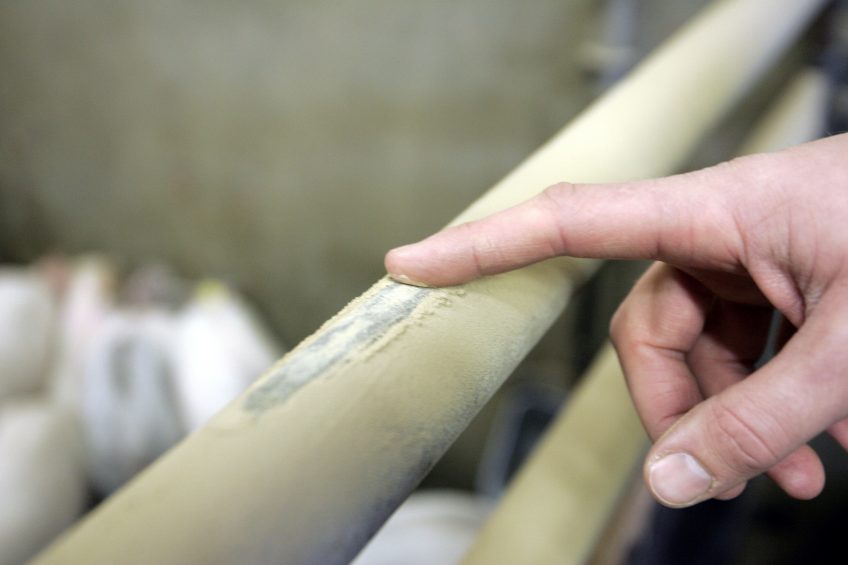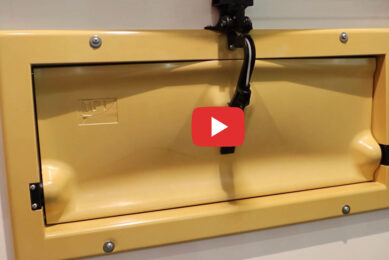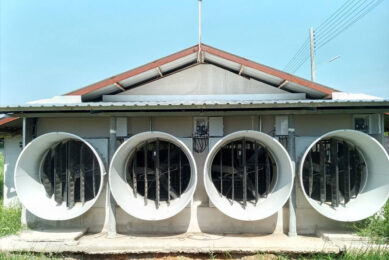Pigs are wet animals – how to deal with it?

Pigs are very wet animals, swine management expert John Gadd tells this month. This has some consequences for the general condition in swine barns. Why does it occur – and where can it occur? There’s more factors involved than one would think.
I last wrote about this here 6 years ago. Encouraged by milder winters in some parts of the world, many farms not yet updating their ventilation systems, with those I have talked to seemingly never having heard of the ‘Coandǎ effect’, it must be time to have another look at what can be done about reducing this annoying problem without recourse to spending too much money.
Also read: Condensation causes considerable problems which some farmers find difficult or expensive to counteract. Read more…
First a brief look at what causes condensation.
- Pigs are very wet animals. Apart from moisture in urine and dung as well as spillage from drinkers, a pen of 12 mid-weight pigs will breathe out 5 litres of moisture a day;
- As this breath is in fine droplet form and warm, it will rise;
- As this warm water vapour rises, it will meet a surface cooler than itself varying from plasterboard, screeded brickwork to something as small as a nailhead;
- It then cools down and the tiny moisture droplets ‘condense’ into water. This is technically called the ‘dewpoint’;
- It can then either be absorbed into the surface it meets making damp patches causing ‘internal rot’, which are costly to remedy. Also as water is an excellent conductor of heat it renders insulation much less effective;
- Alternatively, if the surface is impermeable i.e. resistant to water, then gravity will cause it to fall off, forming puddles on the floor, wetting lying areas and wet pens causing ‘wrong-mucking’, those annoying drips on to your head from nailheads in the ceiling, which can fall into feed hoppers causing spoilage. Another reason apart from flies and birds why feeders should always be covered.
A quadruple whammy
So condensation causes a ‘quadruple whammy’ of damaged surfaces, mucky pigs, poorer growth and more diseases and disorders. As I covered last time the final and best solutions are to update and refurbish insulation to prevent moisture deposition and the same attention to ventilation to prevent the accumulation of wetness.
These complete refurbishments are of course expensive but there are actions we can take at a fraction of the cost to remove damp patches.
How can ‘internal rot’ be prevented?
All producers know the importance of providing a water barrier of 1,000-gauge polythene sheeting before laying a solid floor. It is just as important to do the same between the outer facing board inside a barn, particularly on ceilings and upper walls.
Facing board joins should be sealed with mastic or less permanently with heavy-duty sealing tape. If the surfaces are still greasy or just old and slightly warped, thin timber battens should be nailed to seal them using a dab of insulating paint on the nailheads.
Where else does condensation occur?
Farmers often miss these.
Inside ventilation ducts. Always separate the warm moist air from the cold outer surface of the duct with 25 mm insulation board or wrap. Trunk ventilators condense towards the upper or outside lengths and must always be insulated all the way up. An extractor fan below will have its life shortened rapidly if this is not done.
Drop-out (fail-safe) panels. These often condense on the upper surface so make them from insulation board not plywood.
Valuable tips from my own experience
Look for dead spots where humid air has time to deposit its load of moisture on a cool surface. Vital: use smoke phials or a bee-keeper’s smoke device to see where the air is going, how slowly it is moving and where it is coming from. Only one in ten farmers I visit use either of them. Very short-sighted!
It is often not necessary to increase motive power from the fans to do this as only a gentle flow of continuous air at 0.1 m/sec (10 seconds to cross one metre) – check it with your smoke tube – is needed to keep the moisture from settling. You need to ‘collect’ a portion of the air flow and steer it towards the potential damp patch. Rarely is more air needed, so the fans can proceed at their normal set speed.
How to do this easily, cheaply and efficiently, making use of nature’s ‘Coandǎ effect’, I’ll describe next time.











